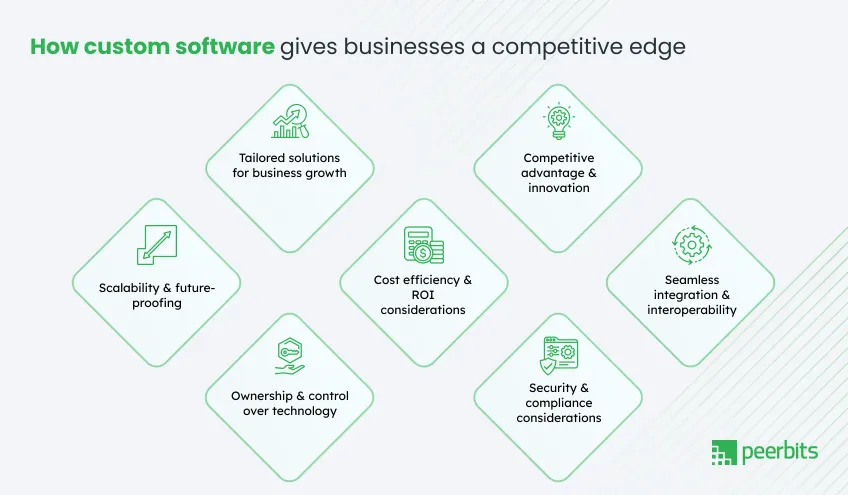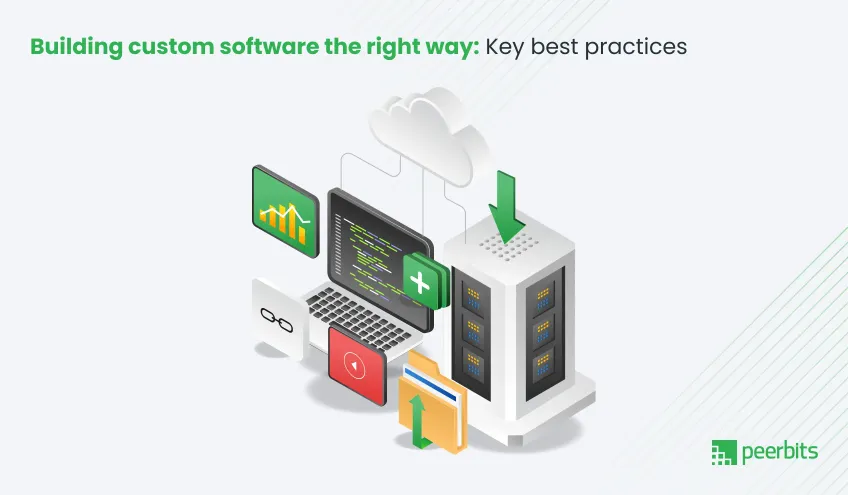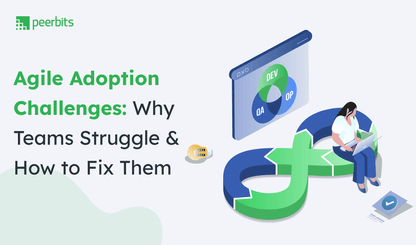In a competitive market, technology plays a decisive role in how efficiently a business operates and how quickly it adapts to change. The right software can support growth, strengthen customer relationships, and simplify day-to-day operations.
Using software that fails to align with your business requirements can limit productivity and slow progress. When the tools you depend on lack critical functions or include unnecessary features, operations become inefficient, teams lose valuable time, and opportunities slip away.
Software development services provides a focused solution by creating applications tailored to your processes, objectives, and customer expectations.
What is custom software development?
Businesses often struggle with software that doesn’t fit their operations. Pre-built solutions may offer general functionality, but they rarely address industry-specific needs. Custom software development provides a customized alternative, helping companies build solutions that align with their unique requirements.
Custom software vs Off-the-shelf software
Custom software development refers to designing, building, and maintaining software tailored to a business’s specific needs. Unlike commercial software, which serves a broad audience, custom solutions focus on solving industry-specific challenges and optimizing workflows.
Companies choose custom software for several reasons:
-
Personalized features: Off-the-shelf software includes unnecessary tools while missing essential ones. Custom solutions include only what’s needed.
-
Scalability: Businesses can expand functionality as they grow instead of being limited by fixed software capabilities.
-
Integration flexibility: Custom solutions connect seamlessly with existing tools, reducing compatibility issues.
-
Stronger security: Industry-specific security features provide better protection compared to mass-market alternatives.
-
Cost-effectiveness in the long run: Although the initial investment is higher, long-term benefits outweigh recurring licensing fees of commercial software.
Key differences between custom and commercial software
| Feature | Custom software | Off-the-shelf software |
|---|---|---|
| Designed for | Specific business needs | General audience |
| Scalability | Scales with business growth | Limited by vendor updates |
| Integration | Seamlessly connects with existing tools | May lack compatibility |
| Security | Tailored security measures | Standard security protocols |
| Upfront cost | Higher | Lower |
| Long-term costs | More cost-effective | Recurring licensing fees |
Industry use cases
Custom software is widely used across industries where standard solutions fail to meet complex requirements.
-
Healthcare: Hospitals and clinics require HIPAA-compliant patient management systems, telemedicine platforms, and AI-based diagnostics.
-
Fintech: Custom banking apps, fraud detection software, and automated financial reporting systems improve security and efficiency.
-
Logistics: Route optimization tools, real-time tracking systems, and warehouse automation enhance supply chain management.
-
SaaS: Companies offering cloud-based services develop tailored applications to serve niche markets with unique functionality.
Businesses that need flexibility, scalability, and industry-specific solutions find custom software development a better long-term investment.
Business benefits of custom software development

Off-the-shelf software often forces businesses to adjust their workflows to fit predefined features. Custom software development eliminates this issue by offering tailored solutions designed specifically for a company's operations.
Tailored solutions for business growth
Every business has unique challenges that generic software cannot always solve. Custom-built solutions address specific pain points, ensuring operations run smoothly.
-
Addressing specific pain points: Companies struggling with inefficiencies, data silos, or workflow bottlenecks benefit from software designed to fix these exact issues.
-
Enhancing workflow automation: Custom software automates repetitive tasks, reducing manual effort and improving overall efficiency.
Scalability & future-proofing
As businesses grow, their software needs change. Custom development allows companies to scale without hitting the limitations of pre-built tools.
-
Adapting software as business needs evolve: Custom solutions expand as needed, accommodating more users, features, or integrations over time.
-
Avoiding limitations of off-the-shelf products: Many commercial software options have fixed capabilities or require expensive upgrades, making long-term scalability difficult.
Cost efficiency & ROI considerations
While custom software may have a higher upfront investment, the long-term benefits outweigh the recurring costs of subscription-based solutions.
-
Long-term savings vs. upfront investment: Unlike commercial software that requires ongoing licensing fees, custom software is a one-time investment with controlled maintenance costs.
-
Custom software vs. subscription-based solutions: Businesses relying on SaaS tools often face increasing subscription fees, whereas custom solutions eliminate these recurring expenses.
Competitive advantage & innovation
Custom software provides businesses with unique tools that help them stand out in a crowded market.
-
Unique features that set businesses apart: Businesses can introduce features that competitors lack, offering better services to customers.
-
Faster response to market changes: Unlike commercial solutions, custom software can be quickly modified to adapt to new industry trends and business demands.
Seamless integration & interoperability
Custom software eliminates compatibility issues by integrating smoothly with existing tools and systems.
-
Connecting with existing tools and systems: Businesses avoid data silos and inefficiencies by linking custom software to their current infrastructure.
-
API-first development approach: Custom solutions often follow an API-first model, making it easier to integrate with third-party applications.
Ownership & control over technology
Owning custom software means businesses are not tied to external vendors for updates, pricing, or feature availability.
-
No dependency on third-party software providers: Businesses avoid unexpected changes, such as pricing hikes or feature discontinuation.
-
Flexibility in customization and modifications: Companies can modify and expand their software based on evolving needs without restrictions.
Security & compliance considerations
Industry regulations demand strict security measures, which custom software can address better than off-the-shelf alternatives.
-
Industry-specific regulations (GDPR, HIPAA, PCI-DSS): Businesses can develop software that meets legal requirements without relying on generic security settings.
-
Custom security measures for data protection: Tailored security protocols protect sensitive business data against unauthorized access and cyber threats.
Businesses investing in custom software gain better control, efficiency, and long-term savings.
Modern trends shaping custom software development

Technology continues to evolve, influencing how businesses develop and use software. Emerging trends are reshaping the industry, helping companies improve efficiency, scalability, and innovation. Here are some key trends driving custom software development in 2025.
AI & machine learning integration
AI-driven solutions are helping businesses make faster decisions and automate complex tasks.
- Automating decision-making and improving efficiency: From predictive analytics in finance to AI-powered chatbots in customer support, businesses are using machine learning to enhance operations.
Cloud-native & serverless computing
Cloud technology remains a game changer, offering flexibility and cost advantages.
- Benefits of cloud platforms for scalability and cost reduction: Cloud-native applications scale dynamically, while serverless computing reduces infrastructure costs by charging only for actual usage.
Low-code/No-code development
Companies are streamlining software development by reducing the need for extensive coding.
- When and where businesses can use these solutions: Low-code/no-code platforms work well for internal applications, rapid prototyping, and automating workflows without extensive development effort.
Blockchain & decentralized applications
Blockchain technology is finding new applications beyond cryptocurrencies.
- Use cases beyond cryptocurrency (e.g., supply chain, contracts): Businesses are leveraging blockchain for secure transactions, smart contracts, and transparent supply chain management.
IoT-enabled software solutions
The Internet of Things (IoT) is transforming industries by enabling real-time data insights.
- Real-time data insights for manufacturing, logistics, and healthcare: IoT-powered software improves predictive maintenance in factories, enhances fleet tracking in logistics, and enables remote monitoring in healthcare.
Read more: Applications of IoT in different industries
Progressive web apps (PWAs) & cross-platform development
Businesses are focusing on delivering seamless user experiences across devices.
- Improving accessibility and reducing costs: PWAs offer near-native performance on web browsers, while cross-platform frameworks like Flutter and React Native reduce development time for mobile applications.
Keeping up with these trends helps businesses stay competitive and future-ready.
Best practices for custom software development

Developing custom software goes beyond writing code. A well-planned strategy helps businesses avoid costly mistakes and build scalable, secure, and maintainable solutions. Here are some best practices to follow.
Agile, DevOps & CI/CD approaches
Modern development methodologies improve collaboration and efficiency.
- How these methodologies improve efficiency and collaboration: Agile methodology ensures adaptability through iterative development, DevOps bridges the gap between development and operations, and CI/CD automates testing and deployment for faster releases.
Security-first development
Security should be a priority from the start, not an afterthought.
- Strategies for minimizing vulnerabilities and cyber threats: Secure coding practices, regular penetration testing, and compliance with industry standards (like GDPR, HIPAA, and PCI-DSS) reduce security risks.
Scalability & future-proofing the software
Software should be designed to handle business growth without requiring major overhauls.
- Building flexible architectures for long-term adaptability: Microservices, cloud-native development, and API-driven architectures help businesses scale seamlessly.
Effective documentation & knowledge management
Clear documentation simplifies maintenance and upgrades.
- Ensuring smooth handover and long-term maintainability: Well-structured documentation helps software developers troubleshoot issues, onboard new team members, and update the software efficiently.
Managing hidden costs & risks
Unexpected expenses can impact project timelines and budgets.
-
Budgeting for unexpected challenges: Accounting for software maintenance, third-party integrations, and compliance requirements along with choosing the right accounting software helps avoid budget overruns.
-
Common pitfalls and how to avoid them: Lack of planning, scope creep, and poor testing can delay projects. A clear roadmap and regular reviews help keep development on track.
Following these best practices ensures custom software remains efficient, secure, and adaptable.
Key challenges in custom software development & how to overcome them
Custom software development brings flexibility but also comes with challenges. Without proper planning, projects can face delays, budget overruns, and inefficiencies. Here’s how to tackle common issues.
Scope creep and changing requirements
Projects often expand beyond the original plan, leading to delays and cost increases.
How to overcome it
- Define clear requirements early: Finalize core features before development starts.
- Use Agile development: Break work into smaller iterations for better adaptability.
- Maintain a feature backlog: Prioritize new requests and schedule them for future updates.
- Implement a change management process: Assess the impact of new features before approval.
Balancing speed, cost, and quality
Rushing development can result in poor quality, while excessive refinement can delay launches. Finding the right balance helps maintain standards and reduce software development cost without sacrificing performance.
How to overcome it
- Focus on an MVP (Minimum Viable Product): Launch with essential features first.
- Invest in automated testing: Detect issues early without slowing development.
- Use CI/CD pipelines: Deploy incremental updates instead of large releases.
- Set realistic deadlines: Consider development complexity and testing time.
Managing cross-team collaboration
Poor communication between teams can cause misunderstandings and inefficiencies.
How to overcome it
- Use project management tools: Platforms like Jira and Trello improve tracking.
- Hold regular check-ins: Weekly meetings align teams and prevent miscommunication.
- Maintain clear documentation: Standardize records for seamless collaboration.
- Define roles clearly: Avoid task overlaps and execution gaps.
Addressing technical debt in long-term projects
Quick fixes and shortcuts can lead to increased maintenance costs and security risks.
How to overcome it
- Follow coding best practices: Keep code clean, modular, and well-documented.
- Schedule regular refactoring: Optimize outdated code to maintain efficiency.
- Use version control: Track changes to simplify updates and rollbacks.
- Plan for long-term maintenance: Allocate resources for post-launch support.
Conclusion
Choosing custom software development company gives your business the ability to design solutions built around specific needs. Unlike off the shelf software, it supports your workflows, scales with growth, and integrates smoothly with existing infrastructure.
A well-planned custom software development process helps remove inefficiencies, reduce the need for multiple tools, and build systems that function exactly as your operations require.
With rapid advancements in AI, cloud computing, and low code technologies, businesses that invest in customized software development today will be in a stronger position to adapt to market changes, meet new customer expectations.

FAQs
Have clear objectives, a list of must-have features, budget parameters, and an understanding of your internal processes. This preparation can help avoid delays and scope changes.
Look for proven experience in your industry, transparent communication, and the ability to provide post-launch support. Checking past project case studies is also essential.
Not necessarily. While upfront costs can be higher, the long-term savings from improved efficiency, fewer license fees, and reduced manual work can outweigh the initial investment.
Work with a partner who signs a non-disclosure agreement (NDA) and follows strict security practices, including code access controls and regular security reviews.
Custom software can be updated or expanded to match new processes.
Some development companies offer phased billing, subscription-based builds, or partnerships with financing providers to make investment more manageable.








